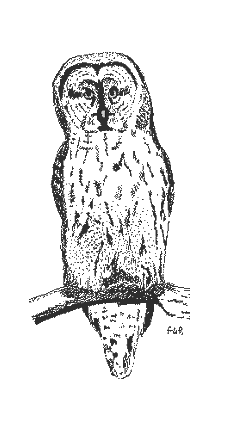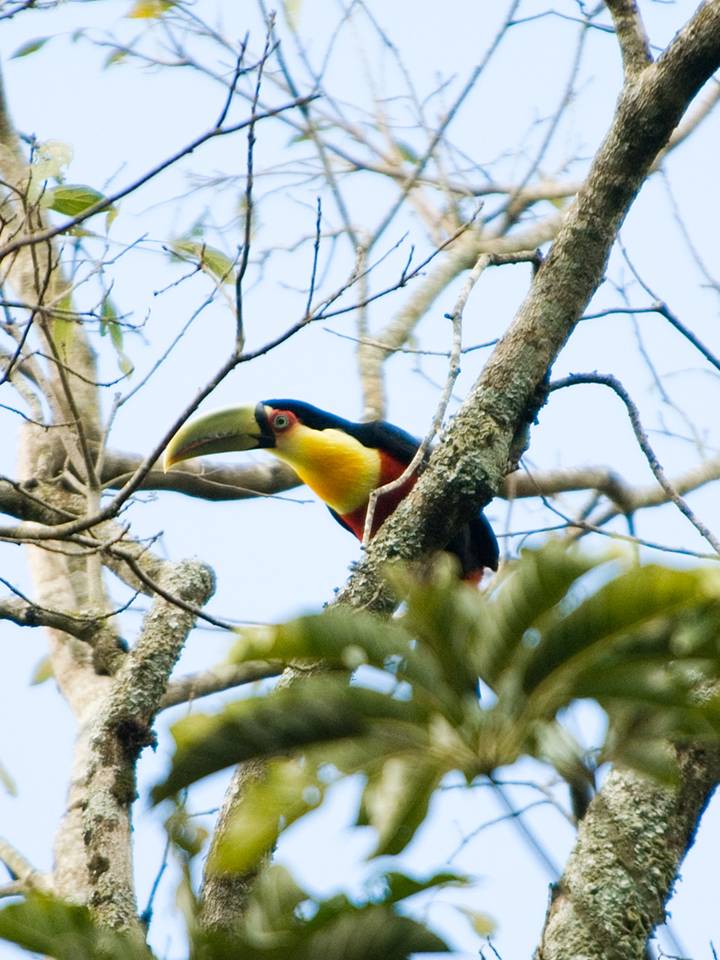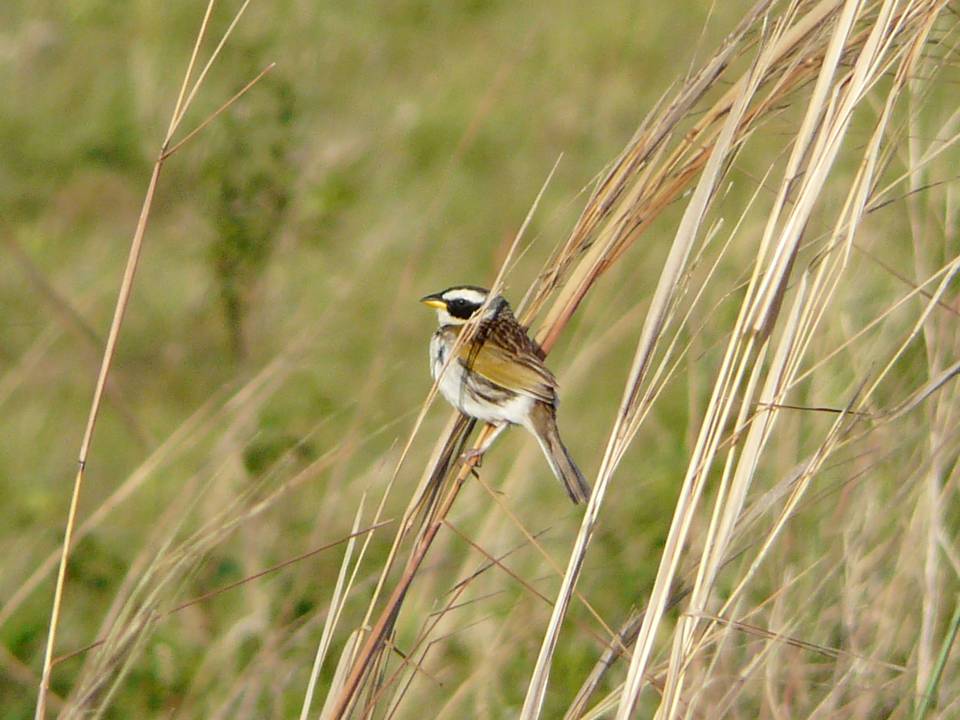Designed by Paul Smith 2006. This website is copyrighted by law.
Material contained herewith may not be used without the prior written permission of FAUNA Paraguay.
Photographs on this web-site were taken by Paul Smith and Silvia Qu and are used with permission.
CERRADO AND ATLANTIC FOREST TOUR
Introduction:
One for the birders, this tour visits two of the most threatened habitats on earth, the cerrado savanna and the humid Atlantic Forest. With high endemism of species this is a fantastic opportunity to tick off a series of localised and globally-threatened species including the endangered White-winged Nightjar, bizarre Cock-tailed Tyrant, elusive Black-masked Finch, diminutive Sharp-tailed Tyrant, raucous Curl-crested Jay and the gaudy Vinaceous Amazon. In just a week you will notch up a list of hard to find species that will be the envy of birders the world over. Click on the image of the Broad-banded Swallowtails to learn more.
Black-masked Finch (right) Coryphaspiza melanotis
FAUNA Paraguay tours are recommended by:
FAUNA Paraguay eco-tours are promoted by:
|
|
|
|
 |
Birdfinders |
|
Main Targets:
Though teeming with marshbirds, our main reason for visiting Arroyos y Esteros is to tick off Strange-tailed Tyrant. Cerrado specialities will be our targets at Laguna Blanca. These include cerrado endemics like White-banded and White-rumped Tanagers, Black-throated Saltator, Curl-crested Jay, Lesser Nothura and of course the critically endangered White-winged Nightjar. Other grassland specialities we would hope for are Black-masked Finch, Cock-tailed Tyrant and Sharp-tailed Tyrant. The possibilities in the Atlantic Forest are endless but our visit to Carapá is in search of the endangered Vinaceous Amazon, with national isolated range species White-wedged Piculet and Horned Screamer a potential bonus.
Recommended duration:
To get the best from this tour we suggest at least 8 days. A minimum of 7 days is required to complete it.
Best time to visit:
This tour is available year round.
Itinerary:
Day 1 - Early departure to Arroyos y Esteros. Continuing after lunch to Laguna Blanca. Optional night drive.
Day 2 - All day birding and wildlife-watching at Laguna Blanca. Night drive.
Day 3 - All day birding and wildlife-watching at Laguna Blanca. Night drive.
Day 4 - Morning birding and departure after lunch to Ciudad del Este. Brief visit to Salto del Monday.
Day 5 - Visit to Itabó Itaipu Reserve.
Day 6 - Morning birding at Itabó and departure to Salto del Guairá.
Day 7 - Early departure and all day birding at Carapá Itaipú Reserve.
Day 8 - Return to Asunción and end of services.
(Itineraries are subject to change according to levels of animal activity or client´s preference.)
What else might we see?:
With Strange-tailed Tyrant and other marshbirds (such as Long-tailed Reedfinch, Crested Doradito, Lesser Grassfinch and Yellow-rumped Marshbird) safely in the bag shortly after leaving Asunción, we will then proceed on to our first cerrado site at Laguna Blanca. We´ll make a brief stop at another marsh on the way, a great place to see two uncommon hummingbirds White-tailed Goldenthroat and Planalto Hermit.
On our first afternoon at Laguna Blanca we will take advantage of the sandy beach and refreshing waters of the crystal clear lake during the hottest part of the day, and as the activty picks up again we will bird the area around the accommodation. Purplish Jay, Short-crested Myiarchus, Rusty-backed Antwren and Scaled Dove will be amongst the possibilities, as well as flocks of Yellow-chevroned and White-eyed Parakeet, Picazuro Pigeon and waterbirds on the lake - at certain times of year including Azure Gallinule. Scrub here is good for seedeaters, including some of the globally-threatend "cappuccino" seedeaters during October and November (such as Dark-throated, Marsh and Chestnut).
Heading out into the cerrado proper we will concentrate on the locally-distributed species for which Laguna Blanca is famous. These include Black-throated Saltator, White-rumped Monjita, Plumbeous Seedeater, White-banded and White-rumped Tanager and the cerrado endemic Curl-crested Jay. Rufous Casironis is also a possibility, along with Suiriri Flycatcher and Mouse-coloured Tyrannulet amongst many others. In grassy areas we may encounter Black-masked Finch, Wedge-tailed Grassfinch, Sharp-tailed Tyrant, Streamer-tailed Tyrant and Cock-tailed Tyrant, the latter performing its charismatic "aeroplane-like" display flights from September to November. The vulnerable Lesser Nothura, a small tinamou, is a target here, this is the only known site for the species outside of Brazil. Other tinamous might include Small-billed, Red-winged and Undulated, as well as Spotted Nothura.
After dark, and given good conditions, Laguna Blanca really comes to life with nightbirds. Little, Scissor-tailed and Rufous Nightjars abound, but the one we will really be looking for is the endangered White-winged, this being one of only three places on earth where it is known to breed. Other nightjars in the forest here may include Pauraque, Ocellated Poorwill and Silky-tailed.
After birding our last morning at Laguna Blanca we will head to Ciudad del Este for some creature comforts. Our last birding stop of the day will be at the waterfall Salto del Monday where we will observe the dramatic site of huge flocks of Great Dusky Swift coming in to roost behind the torrents of water.
Our next site is the Atlantic Forest reserve at Itabó Itaipú. A large list is possible here with patience including Magpie, Sayaca, Black-goggled and Ruby-crowned Tanagers, Saffron-billed Sparrow, Southern Antpipit, Surucua Trogon, Red-breasted Toucan, numerous parrot species and for those who like their birds dull and brown species such as Thrush-like Wren, Planalto Woodcreeper and Euler´s Flycatcher. After dark we may get lucky and find Tropical Screech-owl, Grey Potoo or even a Black-banded Owl. Nine-banded Armadillo is also extremely abundant here, but we will need a big dose of luck to catch a glimpse of Bush Dog.
Carapá reserve located to the north near the town of Salto del Guairá is worth the drive for a handful of species of extremely localised distribution in Paraguay. Our principal target here is the magnificent and endangered Vinaceous Amazon, a species that is in very rapid decline. Another spectacular species we may see is the bizarre Horned Screamer. Listers will also be keen to search for the White-wedged Piculet, which is at the extreme tip of its range in this area.

What does it include?:
The price includes pick-up from and return to Asunción hotel, accommodation, transport, food, non-alcoholic drinks and guiding fees.
It does not include travel insurance, personal expenses, alcoholic drinks or travel costs incurred before the beginning of the tour or after return to Asunción.
For further information or to book your tour email us at faunaparaguay@yahoo.com.ar
Ask about off-season discounts (15 Feb-15 July).
Red-breasted Toucan Ramphastos dicolorus




